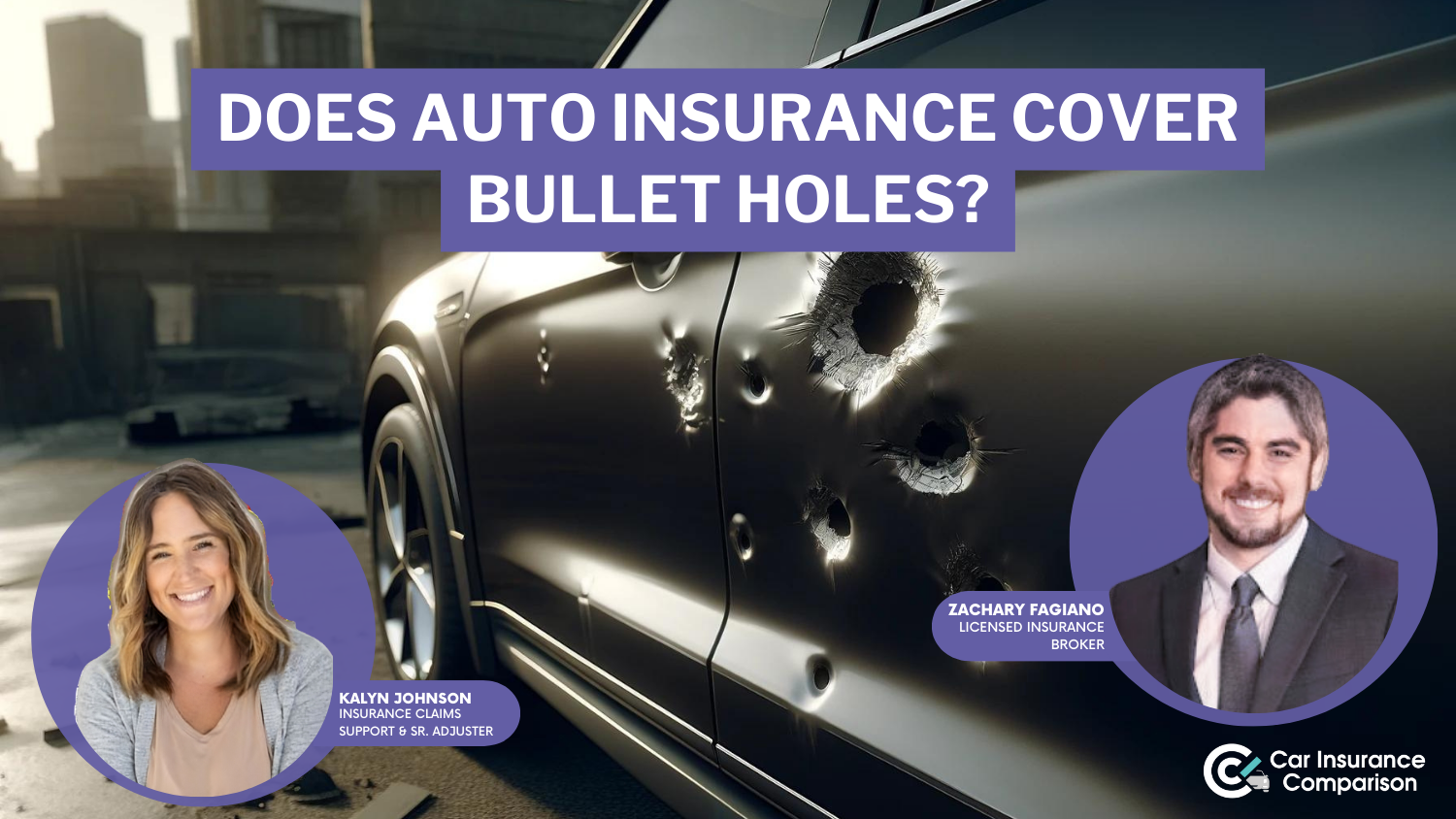How do you find car insurance coverage requirements in your state?
Each state has different car insurance laws. You can find the requirements for your state by visiting its Department of Insurance.
Secured with SHA-256 Encryption





Table of Contents
Table of Contents


Insurance & Finance Analyst
Laura Adams is one of the nation’s leading finance, insurance, and small business authorities. As an award-winning author, spokesperson, and host of the top-rated Money Girl podcast since 2008, millions of readers and listeners benefit from her practical advice. Her mission is to empower consumers to live healthy and rich lives by planning for the future and making smart money decisions. She rec...
Laura D. Adams


Licensed Insurance Agent
Scott W Johnson is an independent insurance agent in California. Principal Broker and founder of Marindependent Insurance Services, Scott brings over 25 years of experience to his clients. His Five President’s Council awards prove he uses all he learned at Avocet, Sprint Nextel, and Farmers Insurance to the benefit of his clients. Scott quickly grasped the unique insurance requirements of his...
Scott W. Johnson
Updated October 2024
Car insurance can be a bit confusing since each state requires a different level and sometimes even different types of car insurance.
However, the Internet provides many great places to find out what the required auto insurance coverage is in your state. Finding car insurance quotes is just as easy when you put your ZIP in the FREE quote box.
While car insurance can seem expensive and a bit of a bother, it is important not only to have it but also to understand it. Since it is illegal to drive without it, you need to buy it.
Since it is an important layer of financial protection, it’s also a good idea to understand what you’re buying so you know you have the right amount.
- Each state has different requirements. You can find the requirements for your state by typing the name of your state and the words, “department of insurance,” into your search engine
- The minimum requirement of your state is usually not enough to fully protect you. Consider increasing your limits and coverage types
- Many drivers do not have insurance, so uninsured/underinsured motorist protection is usually a wise coverage to have
- Look for discounts and consider a higher deductible if you wish to keep your premiums low
Finding the State Minimum Car Insurance
While there are many websites that list the minimum required auto insurance coverage for each state, the most authoritative site is your state government. Other websites might have outdated information whereas your state is required to post the law.
Each state has a department that handles insurance issues. It regulates the entire insurance industry in your state, including home, auto, and life insurance as well as business insurance.
The name of the department can vary a bit from state to state, but most of them call it the Department of Insurance or Insurance Commissioners. However, New York calls it the Department of Financial Services.
The easiest way to find the website for your state is to use your Internet search engine. Type in the name of your state, and then “department of insurance.”
For example, if you live in Colorado, you might type in “Colorado Department of Insurance.” It will bring up the Dora Division of Insurance state website.
Then simply click on “auto” and it takes you immediately to a page that tells you that Colorado requires 25/50/15 liability and med-pay for all car owners.
Free Insurance Comparison
Compare Quotes From Top Companies and Save
Secured with SHA-256 Encryption
What car insurance coverage is required by law?
Nearly every state requires that all car owners carry a minimum amount of liability insurance on their vehicles. Liability insurance pays for the damage you do to another car as well as anyone in that car if you were to cause an accident.
Liability insurance is actually two different types of coverage.
- One is called bodily injury liability. It pays for the medical expenses of the other driver and passengers stemming from injuries sustained in an accident.
- The other is property damage liability. It pays for the damages to the other car or any other property you might damage in an accident.
Levels of liability are typically described using three numbers. The first two numbers are the bodily injury upper limits that the company will pay.
In Colorado, the state minimum for bodily injury is $25,000 per person with a maximum of $50,000 per accident. The third number is the property insurance level. In Colorado, this is no more than $15,000 per accident.
These numbers name the most the company will pay after an accident. If the damages cost less than this, the company will simply pay the actual costs.
Part of the problem is that this amount is different in every state since each state government sets the level within its borders.
The other problem comes if the damages caused by an accident cost more than the limits of your coverage. While $25,000 for medical expenses might sound like a lot, it won’t always cover the expenses of a severe accident.
Let’s say you hit a minivan with a family of four. One adult is critically injured, requiring multiple surgeries and a few days in ICU.
The other three occupants are all hospitalized for a couple of days with lots of tests being run. Then one of the adults needs several weeks of physical therapy after being released.
The adult in ICU could easily exceed the $25,000 and with four people needing medical attention, the total expenses could easily be double the $50,000 accident limit.
If the minivan was worth $25,000, then your $15,000 of property liability will leave you $10,000 short.
This is why industry experts recommend that you choose to buy a higher level of liability coverage than any state requires.
The Insurance Information Institute suggests carrying at least 100/300/50 insurance.
If you have a lot of assets, you might even want to consider an umbrella insurance policy.
What some people don’t realize is that if you are responsible for paying for the damages caused by any accident that is your fault. If you have enough insurance to cover it, that’s great for all concerned.
If you don’t have enough insurance, you may find yourself losing your savings, retirement, or selling assets to come up with the difference.
Uninsured Motorist
Unfortunately, not all drivers follow the law. In fact, you are sharing the road with thousands of uninsured motorists every day. Of course, they are risking a hefty ticket and perhaps an impounded car if they are caught. But how does this affect you?
If you are in an accident caused by someone without insurance, you are put in a hard situation. Legally they are responsible for paying for your damages. The reality is that it is very hard to get money out of someone with no insurance.
Statistically, they are less likely to have much to go after. In fact, usually, their hard financial situation is the reason they aren’t carrying insurance.
The nice thing about uninsured motorist coverage is that it also covers you if the other driver doesn’t have enough insurance. That’s why it’s sometimes called uninsured/underinsured motorist coverage.
If you have a $20,000 car and are hit by a driver with the state minimum $10,000 property liability, who is going to pay the $10,000 difference if the car is totaled?
Your insurance company can sue him, but that takes a long time if they get anything at all. That’s where this policy comes in so handy. It will pay for whatever his insurance doesn’t cover.
An estimated one out of seven drivers has no insurance, though some states have rates as high as one in four.
For this reason, some states require that car owners carry uninsured motorist coverage in addition to liability. This coverage will pay for your car repairs if the other driver has no insurance, or if you are the victim of a hit and run accident and you don’t know who the other driver is.
Even if your state doesn’t require this coverage, it’s a good policy to have for this reason. Usually, claims to this part of the policy don’t cause rate hikes. If you use your collision coverage to get the damages paid for, your rates will probably increase.
Medical Coverage
You also have a choice between two different types of medical coverage.
- The most common type is PIP, or personal injury protection. It’s a bit more comprehensive than the second type, as it not only pays for the medical expenses for anyone in the car but also often pays for funeral expenses, lost wages, and other benefits.
- The second type is medical payments. It also pays for medical expenses for anyone in your vehicles up to a certain amount determined by you when you sign up for the policy.
Both can be used no matter who is at fault in the wreck, though usually, the other driver’s liability will pay if he was at fault.
Some states mandate that drivers have one or the other of these policies, but it is optional in the other states.
While some people choose not to carry these if they have health insurance, others choose to buy it to make sure they have all their bases and their health insurance deductibles covered.
Free Insurance Comparison
Compare Quotes From Top Companies and Save
Secured with SHA-256 Encryption
Comprehensive and Collision
Comprehensive and collision coverage is not required by any state. Legally, they are completely optional. However, all lenders require you have them during the length of any car loan to protect their investments.
Collision pays for your car repairs if you cause an accident. If the car is totaled, you’ll receive the cash value of the car minus the deductible so that you can buy a new car.
Comprehensive coverage pays for damages incurred from anything not related to a traffic incident. This could be replacing the car if it is stolen or paying to have hail dents removed from the hood. This type of policy also has a deductible.
Reducing Insurance Costs
While the state requires that you have a certain amount of insurance, you are free to buy it from any company you wish.
Spend some time comparing quotes from different companies to find the lowest price. There’s a pretty high range of premiums that different companies will charge, so investing the time in this will help you find the lowest cost option.
Another way to keep insurance costs down is to set the deductible high, as high as you can afford. The more deductible you pay, the less the insurance company will charge you each month.
Raising your deductible to $1,000 can save as much as 40 percent off your premium.
The National Association of Insurance Commissioners also suggests asking about discounts. There are many available. Some have to do with you, the driver. If you have a clean driving record, for example, you’ll get a discount for that.
Others have to do with the car. If yours is equipped with the latest air bag technology or a Lo Jack, you’ll receive a good discount for that. The NAIC also has other great tips to reduce your car insurance costs.
Compare quotes now for car insurance rates when you type your ZIP in the FREE rate finder now.
Case Studies: Understanding Car Insurance Coverage Requirements in Different States
Case Study 1: Colorado’s Liability Coverage Requirements
John, a resident of Colorado, is considering purchasing car insurance. He discovers that Colorado requires a minimum liability coverage of 25/50/15. John understands that this means his insurance policy must provide at least $25,000 per person for bodily injury, $50,000 per accident for bodily injury, and $15,000 per accident for property damage.
Case Study 2: Uninsured Motorist Coverage Benefits
Sarah, a cautious driver from California, finds herself in an unfortunate situation. She is involved in an accident caused by an uninsured motorist. Although Sarah’s car sustains significant damage and she requires medical treatment, the at-fault driver lacks the financial means to compensate her adequately. Fortunately, Sarah had the foresight to include uninsured motorist coverage in her policy.
Case Study 3: The Role of Comprehensive and Collision Coverage
Mark, a resident of Texas, is financing a new car through an auto loan. As per the lender’s requirements, Mark must maintain comprehensive and collision coverage throughout the loan period. One day, Mark’s car is severely damaged due to a hailstorm. Thankfully, Mark had comprehensive coverage, which pays for the repairs to his vehicle, minus the deductible.

Frequently Asked Questions
How do I find the car insurance coverage requirements in my state?
To find the car insurance coverage requirements in your state, you can follow these steps:
- Start by visiting the official website of your state’s Department of Insurance. Most states have a dedicated section on their website that provides information about car insurance requirements.
- Look for a tab or link related to “Auto Insurance” or “Car Insurance” on the website’s main menu.
- Once you navigate to the appropriate section, you should find detailed information about the minimum car insurance coverage requirements in your state. This typically includes liability coverage limits for bodily injury and property damage.
- Review the information provided to understand the minimum coverage levels mandated by your state. It’s essential to comply with these requirements to drive legally.
Are car insurance coverage requirements the same in all states?
No, car insurance coverage requirements can vary from state to state. Each state has its own set of minimum coverage limits and regulations. Some states may have more extensive requirements, while others may have relatively lower minimum coverage limits. It’s crucial to familiarize yourself with the specific requirements in your state to ensure compliance.
What are the common types of car insurance coverage?
While car insurance requirements may vary, several common types of coverage exist, including:
- Liability coverage: This coverage helps pay for injuries or property damage you cause to others in an accident.
- Collision coverage: It pays for damages to your own vehicle caused by a collision, regardless of who is at fault.
- Comprehensive coverage: It covers damages to your vehicle caused by incidents other than collisions, such as theft, vandalism, natural disasters, or falling objects.
- Uninsured/underinsured motorist coverage: This coverage protects you if you’re involved in an accident with a driver who has insufficient or no insurance.
- Personal injury protection (PIP) or medical payments coverage: It covers medical expenses for you and your passengers in case of injuries resulting from an accident, regardless of fault.
Do I need to purchase additional coverage beyond the minimum requirements?
While meeting the minimum car insurance requirements is mandatory in most states, it’s often advisable to consider purchasing additional coverage. The minimum limits may not provide sufficient protection in the event of a severe accident. Additional coverage can offer more financial security and help protect your assets. Factors like your vehicle’s value, your driving habits, and personal circumstances can influence the need for additional coverage. Consult with an insurance agent to assess your specific needs.
Can I drive in another state if I have insurance coverage in my home state?
In general, if you have car insurance coverage that meets or exceeds the minimum requirements of your home state, it will provide you with coverage when driving in another state. However, it’s essential to review your policy and check with your insurance provider to ensure that you have proper coverage when traveling out of state. Some policies may have limitations or restrictions regarding coverage in other states, so it’s always wise to confirm beforehand.
Get a FREE Quote in Minutes
Insurance rates change constantly — we help you stay ahead by making it easy to compare top options and save.






